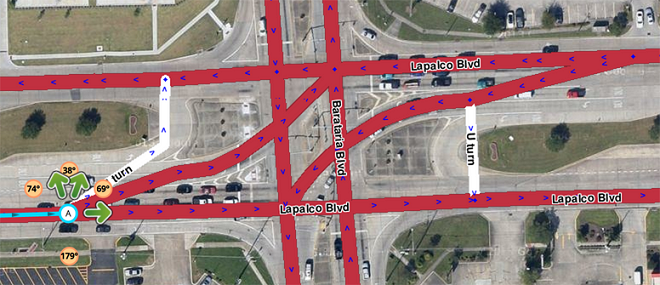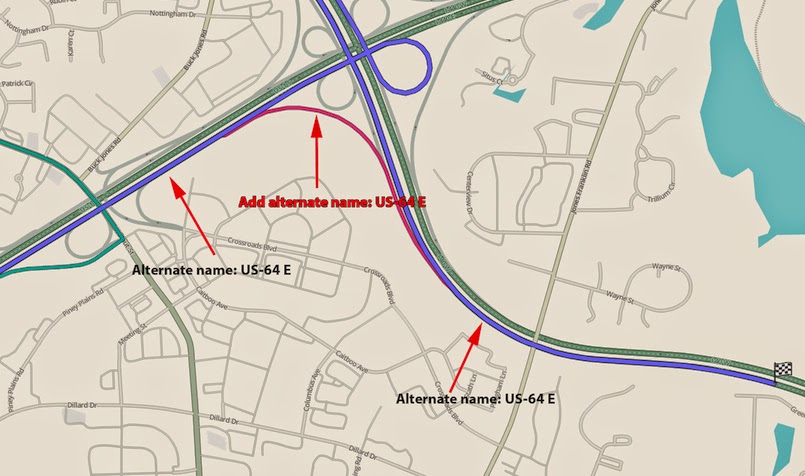(Criou página com '<!--if the section parameter is defined, do not place the visible banner, only as the code block for the top of a section-->{{GlobalMark/visible}} <!-- #####-----#####-----##...') |
(Traduzindo...) |
||
| Linha 17: | Linha 17: | ||
#####-----#####-----#####-----#####-----#####-----#####-----#####-----#####--> | #####-----#####-----#####-----#####-----#####-----#####-----#####-----#####--> | ||
== | ==Grandes Desvios== | ||
Waze | O algoritmo de roteamento do Waze possui mecanismos que previnem rotas de sair de uma rodovia para em seguida voltar para a mesma rodovia. Motoristas em geral preferem continuar numa mesma rodovia, mesmo que o Waze calcule uma rota mais rapida ou curta utilizando ruas ou avenidas para em seguida retornar a rodovia. | ||
Waze | Waze irá reduzir a possiblidade de um desvio de uma rodovia e de volta para a mesma rodovia quando '''todas''' as seguintes condições ocorrerem: | ||
# | # Todos os segmentos da rodovia incluindo o primeiro antes do possivel desvio e o primeiro após o possivel desvio precisam ter o mesmo nome (ou nome alternativo). Segmentos sem nome não são considerados como tendo o mesmo nome, | ||
# | # o desvio tem mais de um segmento e | ||
# | # o desvio está abaixo do limite de distância definido abaixo | ||
{| class="wikitable" | {| class="wikitable" | ||
|- | |- | ||
! | ! TIPO DE VIA !! LIMITE | ||
|- | |- | ||
| {{Freeway}} || 5km | | {{Freeway}} || 5km | ||
| Linha 36: | Linha 36: | ||
|} | |} | ||
É importante entender que o Waze utiliza um sistema de roteamento baseado em penalidades. Ele computa o total de penalidades de uma rota e seleciona a rota com o menor número de penalidades. Então é possivel haver um desvio se a rota principal for extremamente lenta. | |||
=== | ===Avisos=== | ||
* | * Em rodovias duplicadas que possuem o mesmo nome dos dois lados, o mecanismo de grandes desvios irá prevenir retornos que utilizem mais de um segmento. Na interseção abaixo se o motorista vier da esquerda é possivel fazer o retorno por utilizar apenas um segmento, mas se vier da direita '''não''' é possivel fazer o retorno porque dois segmentos são utilizados. | ||
[[File:UDetour.png|border|center]] | [[File:UDetour.png|border|center]] | ||
* | * Cuidado com "falsos positivos". For example, where route number concurrencies begin and end, the big detour mechanism may be unexpectedly triggered as follows (see diagram): | ||
** In a concurrency, two highways share the same road, and both names will appear on the concurrent segments, using [[Alternate names]]. Where the concurrency ends, the two highways split into separate roadways again. | ** In a concurrency, two highways share the same road, and both names will appear on the concurrent segments, using [[Alternate names]]. Where the concurrency ends, the two highways split into separate roadways again. | ||
** Often, there are ramp segments connecting the last concurrent segment to one or both of the non-concurrent continuations. If the concurrency was of I-1234 and I-4567, for example, there might be a ramp named "to I-1234 / Sometown" - a name which contains "I-1234" but is not identical to the highway name. | ** Often, there are ramp segments connecting the last concurrent segment to one or both of the non-concurrent continuations. If the concurrency was of I-1234 and I-4567, for example, there might be a ramp named "to I-1234 / Sometown" - a name which contains "I-1234" but is not identical to the highway name. | ||
Edição das 04h37min de 8 de maio de 2017
Grandes Desvios
O algoritmo de roteamento do Waze possui mecanismos que previnem rotas de sair de uma rodovia para em seguida voltar para a mesma rodovia. Motoristas em geral preferem continuar numa mesma rodovia, mesmo que o Waze calcule uma rota mais rapida ou curta utilizando ruas ou avenidas para em seguida retornar a rodovia.
Waze irá reduzir a possiblidade de um desvio de uma rodovia e de volta para a mesma rodovia quando todas as seguintes condições ocorrerem:
- Todos os segmentos da rodovia incluindo o primeiro antes do possivel desvio e o primeiro após o possivel desvio precisam ter o mesmo nome (ou nome alternativo). Segmentos sem nome não são considerados como tendo o mesmo nome,
- o desvio tem mais de um segmento e
- o desvio está abaixo do limite de distância definido abaixo
| TIPO DE VIA | LIMITE |
|---|---|
| Via Expressa | 5km |
| Federal | 5km |
| Estadual | 500m |
É importante entender que o Waze utiliza um sistema de roteamento baseado em penalidades. Ele computa o total de penalidades de uma rota e seleciona a rota com o menor número de penalidades. Então é possivel haver um desvio se a rota principal for extremamente lenta.
Avisos
- Em rodovias duplicadas que possuem o mesmo nome dos dois lados, o mecanismo de grandes desvios irá prevenir retornos que utilizem mais de um segmento. Na interseção abaixo se o motorista vier da esquerda é possivel fazer o retorno por utilizar apenas um segmento, mas se vier da direita não é possivel fazer o retorno porque dois segmentos são utilizados.

- Cuidado com "falsos positivos". For example, where route number concurrencies begin and end, the big detour mechanism may be unexpectedly triggered as follows (see diagram):
- In a concurrency, two highways share the same road, and both names will appear on the concurrent segments, using Alternate names. Where the concurrency ends, the two highways split into separate roadways again.
- Often, there are ramp segments connecting the last concurrent segment to one or both of the non-concurrent continuations. If the concurrency was of I-1234 and I-4567, for example, there might be a ramp named "to I-1234 / Sometown" - a name which contains "I-1234" but is not identical to the highway name.
- If the ramp does not also carry a simple alternate name of "I-1234", then there is a discontinuity of the highway name between the concurrency and the continuation highway. If there are two ramp segments like this, it will trigger Big Detour Prevention unexpectedly, and Waze will create an unneeded penalty for continuing on I-1234.
- To prevent this, just assign I-1234 as an alternate name to all ramps between the two sections (concurrency and continuation). Note that if there is only a single ramp segment connecting the highways, there will not be a "false positive." Nevertheless, it is a good practice to do this even for a single ramp segment, in case the ramp is cut into two segments later, either by accident or because later construction or map improvements connect another feeder ramp in the middle.
- Another example of a false positive could occur where a highway has multiple wayfinders connected one to another (for example, if there are several multi-lane exits in a row).

Small Detours
Waze has a small detour prevention mechanism to deal with instances where Waze calculates that a left turn can be "optimized" by using U-turns and right turns (either continue straight, U-turn, right turn; or alternatively, immediate right turn, U-turn, continue straight). While this may save a few seconds over waiting for a long average left turn, it is undesirable. Waze will prevent such detours if there is not a measurable difference in the route times. The exact difference in time required to trigger this prevention is proprietary, and subject to change as needed.